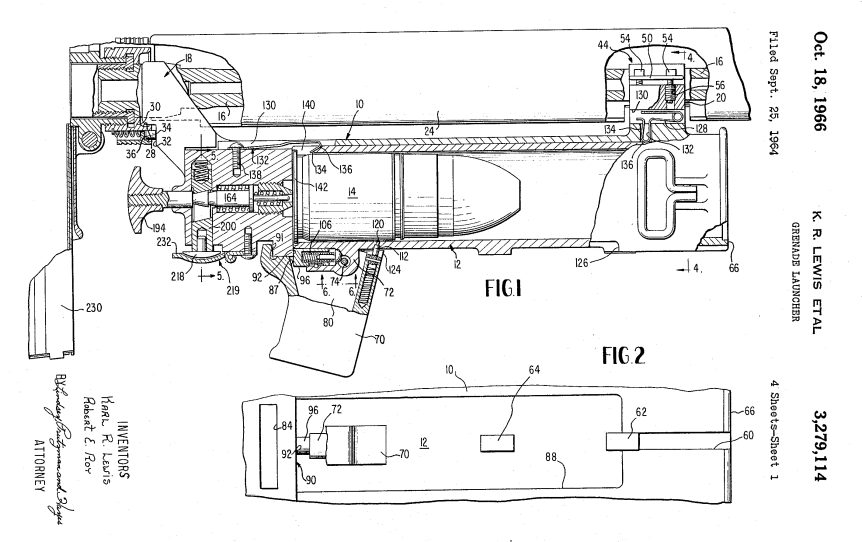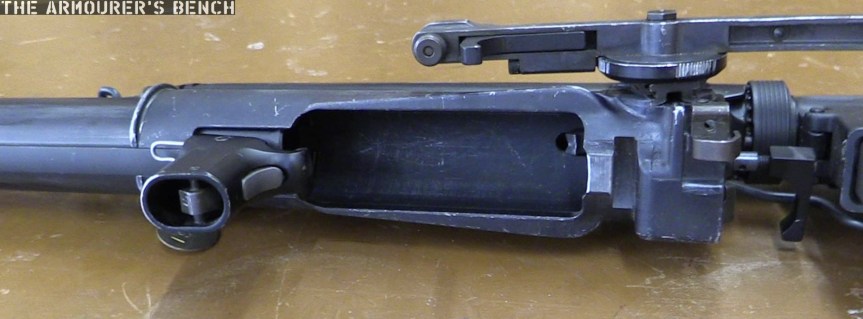Here’s Vic’s video on the XM148, check out Matt’s article below:
There have been attempts to fire grenades from the infantryman’s weapon since the 17th century. Up until the 1960s these almost entirely involved muzzle attachments or grenades which could be fired off the end of a rifle’s barrel. In May 1963, the US military called for a new ‘underslung’ grenade launcher to complement the AR-15/M16, then in early testing. The grenade launcher program had its roots in the ultimately unsuccessful Special Purpose Individual Weapon (SPIW) program which had begun in 1952.
While a series of designs were developed by various manufacturers and designers, May 1964 saw Colt unveil the CGL-4. The Colt was tested against designs from Springfield Armory and Ford, a design from AAI was promising but it was not able to chamber the 40x46mm rounds used by the M79 and was rejected. The US military sought munitions commonality between the M79, already in service, and the new rifle-mounted grenade launcher.

In March 1965, the CGL-4 was chosen for further testing and a contract for 30 launchers was signed. The CGL-4 was reportedly developed by Karl Lewis and Robert E. Roy in just 48 days. However, the design was complex. To load the barrel housing slid forward allowing a grenade to be placed in the breech, the weapon was then cocked and a long trigger, which projected back towards the rifle’s trigger guard, could be pulled to fire the weapon.

Despite some problems with barrel housings cracking an order for 10,500 of the new launchers, now designated the XM148, was placed in January 1966. Production capacity issues and problems with the launcher’s sight lead to production delays and it wasn’t until December 1966, that the first shipment of 1,764 launchers arrived in Vietnam for field testing.

Initial reports from the field were promising with troops praising the “tactical advantage of both the point fire and area fire system” concept. The XM148 was well received by the SEALs and the Australian SAS. The armourers of the Australian SAS, deployed to Vietnam with the 1st Australian Task Force, were also hard at work attaching XM148s to L1A1 rifles. Removing the L1A1′s handguard and attaching the XM148 to the rifle’s barrel.
Field testing was carried out by 12 units from six different divisions which were operating in various parts of Vietnam. This gave a wide variety of terrains and yielded some interesting results. In general it was found that the XM148 decreased rate and quantity of the grenadier’s fire, it slowed his reaction times when firing at a target, it hampered his movement in dense vegetation and also meant the grenadier had to spend longer caring for his weapon.

It was noted that the sight mount which was overly complex and prone to snagging on brush and kit, it was also felt that too much force was needed to cock the XM148 (around 30 lbs) and the trigger mechanism was felt to be overly complex and difficult to repair and disassemble. One safety concern was the XM148′s long trigger bar, which could snag and launch a round – not ideal for special forces patrols infiltrating through thick bush. Problems with the launcher’s quadrant sights also continued causing deflection errors out at longer ranges. The bulkiness of the sights exasperated these problems as when they were knocked the XM148′s zero could be effected. The XM148 also precluded the use of a bayonet as when fired it would blow the bayonet off the muzzle. Overall, troops felt the XM148 was too fragile and complex for use in the field.

At least one unit found use for the launchers, the 1st Cavalry Division (Airmobile)’s Operational Report for Quarterly Period Ending 31 October 1967, noted that the XM148
“proved unsatisfactory in infantry units due to its lack of durability; consequently, USARV directed that they be turned in. However, 1/9 Cav has devised a method of mounting the launcher coaxially on the M60C machine gun used by scout observers on OH-13 scout helicopters. Durability in this environment is
not a problem since the weapon deos not receive the rough handling it did in the hands of ground troops. Firepower on scout helicopters is significantly increased. Fifty-two XM148s have been retained for use by 1/9 CAV.”
Finally, despite Colt’s efforts to rectify the growing list of problems the Army Concept Team In Vietnam deemed the XM148 unsatisfactory for deployment in Vietnam and recommended they be removed from service and a new improved launcher be developed. This was a massive blow to Colt who had already manufactured 27,400 XM148s. Many of these were already in Vietnam.
The US Army launched the Grenade Launcher Attachment Development (GLAD) program in the summer of 1967. A large number of manufacturers submitted designs including Colt, who offered the improved Henry Into-designed CGL-5. The Army turned down Colt’s offer of 20 free improved launchers and rejected the CGL-5 outright. The GLAD program saw the resurgence of the earlier AAI design, designated the XM203, this simple design, now chambering the 40x46mm shell, was eventually selected in August 1968. Ironically, as AAI was predominantly a research and development company and after an initial run of 10,000 made by AAI, Colt was subsequently awarded the contract to manufacture the M203 from 1971 onwards.

While the XM148 proved to be a failure it played an important role in proving the operational viability of the rifle mounted grenade launcher system. The muzzle-launched rifle grenade is all but obsolete, superseded by the under-slung grenade launcher.
If you enjoyed the video and this article please consider supporting our work here.
Specifications:
Length: 16.5 inches
Weight: ~3lbs
Calibre: 40x46mm
Action: single shot, striker-fired single action
Capacity: 1
Rate of Fire: ~4 rpm
Bibliography
Black Rifle, E.C. Ezell & R. Blake Stevens, (1987)
Colt Industries Newsletter, Vol.2 no.3, May 1967, (source)
‘Grenade launcher having a rotatable forwardly sliding barrel and removable firing mechanism’, US Patent #3507067, H.A. Into, 14/12/67 (source)
Operational Report for Quarterly Period Ending 31 October 1967, 1st Cavalry Division (Airmobile), (source)
‘Grenade launcher’, US Patent #3279114, K. Lewis & R. Roy, 25/09/64 (source)
Springfield Armory Database entries: 1 2 3
40mm Shoulder-Fired Grenade Launchers & the SEALS, Small Arms Review, K. Dockery, (source)
The XM148: Birth of the Mounted 40mm Grenade Launcher, Small Arms Review, J. Wong, (source)
My thanks to Daniel Watters for information on AAI & Colt M203 production contracts.

One thought on “Colt CGL-4 (XM148) 40mm Grenade Launcher”